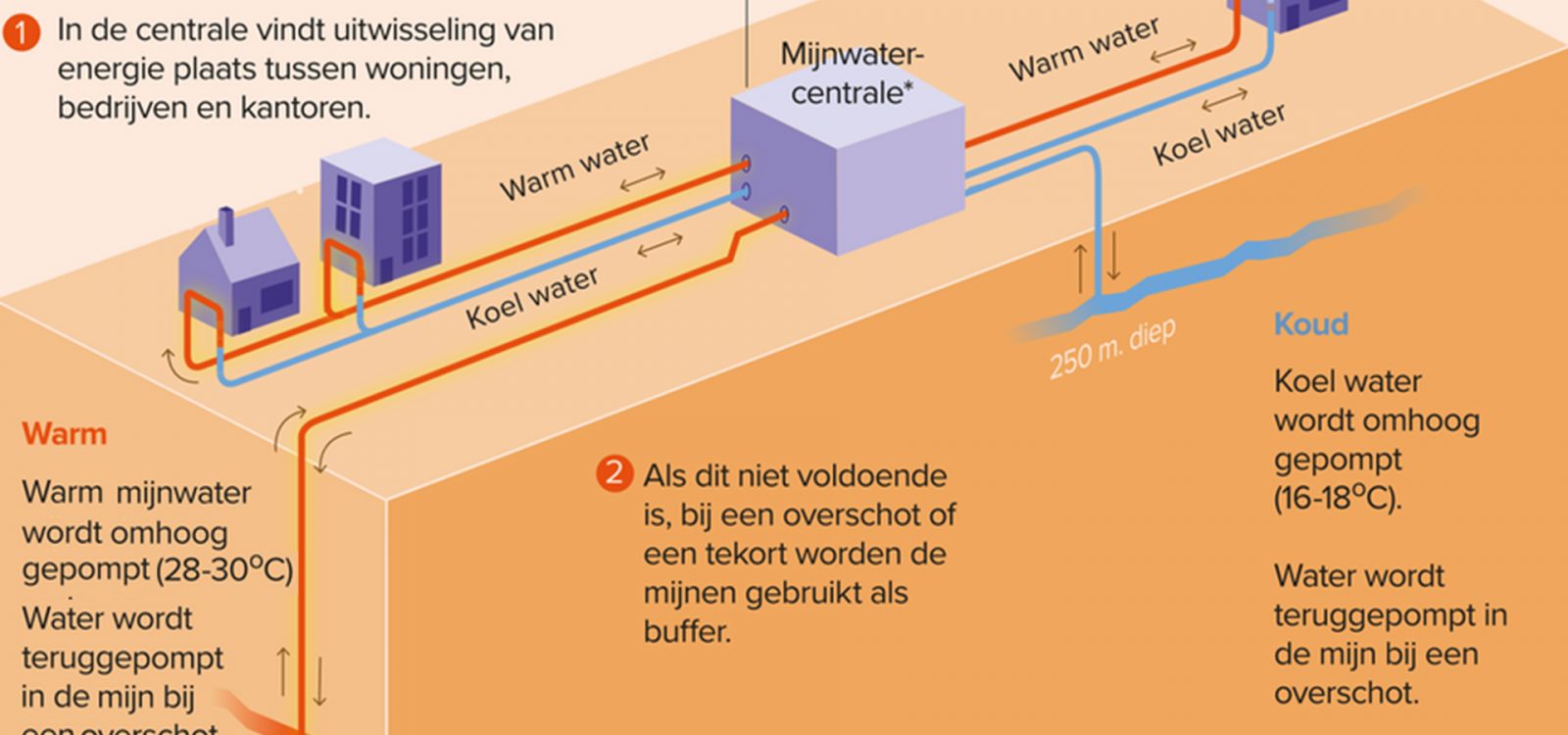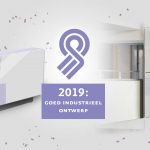The mines in Southern Limburg were abandoned for decades.
For decades, the mines of Southern Limburg were abandoned. Until the local authority of Heerlen planned to use the groundwater located in the mines for the heating of buildings. For this, a special corporation was set up, that now has national ambitions for this idea.
It began with Elianne Demollin-Schneiders – civil servant of Heerlen – that, in 2003, realized that there was a whole network of mine space beneath her feet. Abandoned by miners who dug for coal up to the 1970’s. These spaces were filled with groundwater. This groundwater, because of its depth, was warm. Demollin-Schneider realized that this water could be used for heating up homes, without the use of natural gas.
Two years later a start was made with the drilling of five wells. Old miners helped in deciding where to drill, since they knew a lot about the mine network underground. A piping network of eight kilometers in length delivered hot water, coming from 800 meter deep, to an office building and a residential area. Cold water from higher situated mine networks was used for cooling. The first connection from Mijnwater were a fact. Louis Hiddes (69), director of Mijnwater, is standing in the basement of Maankwartier, a newly-built quarter surrounding the Heerlen station. Enthusiastically, he points to two black pipes that transport mine water. The water coming from the deeper networks has a temperature between 28°C and 30°C. The water from higher networks has a atemperature between 16°C and 18°C.
The mining of Limburg flourished in the first half of the 20th century. After WWII the decay started. The last mine was closed in 1974.
In the next room mine water is transported through a heat exchange unit, a device that provides heat or cold to other water. This water then flows through the residences and shops of Maankwartier. The water from the mines cannot flow directly through the buildings, because it is strongly contaminated with metals and coal residue. Because the water, that runs through the heating pipes of the residences, needs to be around the 36°C, the humming of the heat exchange units can be heard in the basement.
Apart from the mine
Since 2005, Hiddes and his nineteen coworkers have developed the technique heavily. Not everywhere in the region can mine water be tapped, a technique known as geothermics. Mijnwater increasingly makes use of residual heat from the environment. Heat that remains after cooling of buildings, or with industrial processes. The Maankwartier for instance, receives heat from the cooling installations from a supermarket in the same building. These installations are very hot at the backside. Also data centers, ice skating rinks and even residences that are heated by Mijnwater, are good candidates to subtract heat of cold from.
3.000.000 According to the consultancies CE Delft and IF Technologies 2,6 to 3 million residences are fit for heating using the Mijnwater technique.
The company currently operates on a small scale. Mijnwater provides around 350 residences, a couple of offices and shops, two schools, a kindergarten and a sports center with heat. Another 500 residences in a new natural gas free area in Brunssum are planned for connection to mine water. But Hiddes has more ambitious plans. In 2030, the director wants to provide 30.000 residences with heating and cooling. ‘Looking at the objectives from Parijs, we even want a lot more,’ he says.
Earnings for the region
This mine water is a great opportunity for the region. Since the mines are closed, the area of Heerlen, Kerkrade and Brunssum suffers from poverty that is passed on from generation to generation. Recently, the region received €40 million from the government to improve the quality of life. Volmar Delheij, program manager space and mobility, sits in the office of the region. The building is built in 1975 after closure of the mines. For thirty years it accommodated the Central Office of Statistics, that had to attract more work to the region. This succeeded only partly because the new jobs consisted mainly of office work. Not very suitable for thousands of miners that suddenly were out of job and income. Delheij hopes that the supply of energy by local businesses results in more jobs and income to the region. He calculated that when the cooperation between municipal authorities began six years ago, the residents of Parkstad paid €500 million a year on energy bills. 98% of that went to energy cooperations outside the region. ‘If you could do that only regionally, you can place all that extra money in your income box.’
Three million residences.
Hiddes has even bigger ambitions: he wants to become active outside Parkstad too. In places where there are no mines, heat that is collected in the summer can be stored in underground water barrels. On top of that, the company extracts a decreasing volume of warmth and cold from the mines, making it more efficient. At this moment 35% of the total heat and cold that is supplied by Mijnwater comes from the mines. The director hopes that this can become 15% to 20% in a couple of years. And he is not the only one that is optimistic. Consultancies CE Delft and IF Technologie calculated that 2,6 to 3 million residences are fit for connection with the technology of Mijnwater. In total, The Netherlands is good for about 7 million homes. The techniques that Mijnwater uses are allready applied in other parts of Holland, says director Frans Rooijers of CE Delft. However, what makes Mijnwater different is that they can combine all of these techniques into a even more efficient one. Furthermore, it measures exactly how much heat a residence needs at a certain time. It gradually starts supplying it at an early stage so the residence doesn’t need very hot water in one time. This saves energy. ‘We need these things in the energy transition, but they aren’t very common yet,’ says Rooijers. The province of Limburg bought Mijnwater for €16 million last year from Heerlen’s local authority, because the board saw chances for heating and cooling building across the whole province. In June, the province incvested another €22 million. Hiddes managed to extract €12,5 million in European subsidies. Combining the investments of Heerlen’s local authority and the EU, €70 million euros of public funds go to Mijnwater.
No profit yet
The company doesn’t make profit yet. Hiddes seems to get somewhat bothered when questioned when the investments will start to pay back. ‘You have to think in the long term. When we build the metro in Paris, it didn’t pay off as well. The technique displays some mallfunctions here and there. This was noticable when visiting teh residence of Frans Keet (68), living on the 8th floor of the Maankwartier. The floor feels cold, while the thermostat says it is 24°C. A clear sign that the pipes beneath the floor need to cool a lot more. According to Keet, other neighbors have the same issues.

The director has enough ideas for large scale expansion. He shows a picture of a maquette for existing residences in the basement. Connected to the arcade of an appartment building there stands a big column, where pipes are running through with warm and cold water. In this column, air is heated and cooled with this water that is blown into the residence through the ventilation system. This doesn’t need a lot less renovation than a system with underfloor heating, he explains.
Gas price
Rooijers believes that Mijnwater can become very big in The Netherlands. To accomplish this, sufficient companies are needed that are willing to take over the technique to install it at other places. But this is tricky. The exchange and dosage of heat needs to happen extremely careful. ‘There are only a handful of companies that know how to develop such a smart system and want to become involved in such a contracted position.’ Mijnwater monitors and maintains the systems as long as they are used, making them stay in close contact with clients. They cannot suddenly change from energy supplier. Besides this, gas prices play a role. As long as gas prices are low, alternatives are easily more expensive. ‘When staying away from using natural gas becomes the standard, this becomes an interesting system,’ says Rooijers. Therefore he finds that it is important for the minister to raise the gas price even higher, so Holland can become free of natural gas more quickly. Delheij hopes that Mijnwater can expand there business as well, because the region needs the company now that a plan is asked for all residences to step off from natural gas. ‘It is a good system and it is the only supplier in the region. We may praise ourselves lucky for having an entrepreneur that wants to help in getting homes free from natural gas at such a large scale. We can do this. We have to.’




